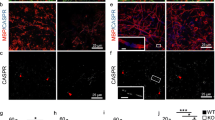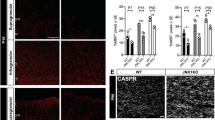Abstract
Increasing evidence suggests that a cyclic adenosine monophosphate (cAMP)-dependent intracellular signal drives the process of myelination. Yet, the signal transduction underlying the action of cAMP on central nervous system myelination remains undefined. In the present work, we sought to determine the role of EPAC (exchange protein activated by cAMP), a downstream effector of cAMP, in the development of the myelin sheath using EPAC1 and EPAC2 double-knockout (EPACdKO) mice. The results showed an age-dependent regulatory effect of EPAC1 and EPAC2 on myelin development, as their deficiency caused more myelin sheaths in postnatal early but not late adult mice. Knockout of EPAC promoted the proliferation of oligodendrocyte precursor cells and had diverse effects on myelin-related transcription factors, which in turn increased the expression of myelin-related proteins. These results indicate that EPAC proteins are negative regulators of myelination and may be promising targets for the treatment of myelin-related diseases.





Similar content being viewed by others
Change history
07 May 2020
The original version of this article unfortunately contained a mistake.
References
Simons M, Nave KA. Oligodendrocytes: myelination and axonal support. Cold Spring Harb Perspect Biol 2015, 8: a020479.
Rowitch DH. Glial specification in the vertebrate neural tube. Nat Rev Neurosci 2004, 5: 409–419.
Wang S, Sdrulla AD, diSibio G, Bush G, Nofziger D, Hicks C, et al. Notch receptor activation inhibits oligodendrocyte differentiation. Neuron 1998, 21: 63–75.
Charles P, Hernandez MP, Stankoff B, Aigrot MS, Colin C, Rougon G, et al. Negative regulation of central nervous system myelination by polysialylated-neural cell adhesion molecule. Proc Natl Acad Sci U S A 2000, 97: 7585–7590.
Mi S, Miller RH, Lee X, Scott ML, Shulag-Morskaya S, Shao Z, et al. LINGO-1 negatively regulates myelination by oligodendrocytes. Nat Neurosci 2005, 8: 745–751.
Fu H, Qi Y, Tan M, Cai J, Takebayashi H, Nakafuku M, et al. Dual origin of spinal oligodendrocyte progenitors and evidence for the cooperative role of Olig2 and Nkx2.2 in the control of oligodendrocyte differentiation. Development 2002, 129: 681–693.
Arnett HA, Fancy SP, Alberta JA, Zhao C, Plant SR, Kaing S, et al. bHLH transcription factor Olig1 is required to repair demyelinated lesions in the CNS. Science 2004, 306: 2111–2115.
Battiste J, Helms AW, Kim EJ, Savage TK, Lagace DC, Mandyam CD, et al. Ascl1 defines sequentially generated lineage-restricted neuronal and oligodendrocyte precursor cells in the spinal cord. Development 2007, 134: 285–293.
He Y, Dupree J, Wang J, Sandoval J, Li J, Liu H, et al. Casaccia-Bonnefil P The transcription factor YinYang 1 is essential for oligodendrocyte progenitor differentiation. Neuron 2007, 55: 217–230.
Emery B, Agalliu D, Cahoy JD, Watkins TA, Dugas JC, Mulinyawe SB, et al. Myelin gene regulatory factor is a critical transcriptional regulator required for CNS myelination. Cell 2009, 138: 172–185.
Pringle NP, Mudhar HS, Collarini EJ, Richardson WD. PDGF receptors in the rat CNS: during late neurogenesis, PDGF alpha-receptor expression appears to be restricted to glial cells of the oligodendrocyte lineage. Development 1992, 115: 535–551.
Spassky N, de Castro F, Le Bras B, Heydon K, Quéraud-LeSaux F, Bloch-Gallego E, et al. Directional guidance of oligodendroglial migration by class 3 semaphorins and netrin-1. J Neurosci 2002, 22: 5992–6004.
Tsai HH, Macklin WB, Miller RH. Netrin-1 is required for the normal development of spinal cord oligodendrocytes. J Neurosci 2006, 26: 1913–1922.
Filipovic R, Zecevic N. The effect of CXCL1 on human fetal oligodendrocyte progenitor cells. Glia 2008, 56: 1–15.
Furusho M, Ishii A, Bansal R. Signaling by FGF receptor 2, not FGF receptor 1, regulates myelin thickness through activation of ERK1/2-MAPK, which promotes mTORC1 activity in an Akt-independent manner. J Neurosci 2017, 37: 2931–2946.
Malone M, Gary D, Yang IH, Miglioretti A, Houdayer T, Thakor N, et al. Neuronal activity promotes myelination via a cAMP pathway. Glia 2013, 61: 843–854.
Vakilzadeh G, Khodagholi F, Ghadiri T, Darvishi M, Ghaemi A, Noorbakhsh F, et al. Protective effect of a cAMP analogue on behavioral deficits and neuropathological changes in cuprizone model of demyelination. Mol Neurobiol 2015, 52:130–141.
Cheng X, Ji Z, Tsalkova T, Mei F. Epac and PKA: a tale of two intracellular cAMP receptors. Acta Biochim Biophys Sin 2008, 40: 651–662.
Yang Y, Shu X, Liu D, Shang Y, Wu Y, Pei L, et al. EPAC null mutation impairs learning and social interactions via aberrant regulation of miR-124 and Zif268 translation. Neuron 2012, 73: 774–788.
Xie YJ, Zhou L, Wang Y, Jiang NW, Cao S, Shao CY, et al. Leucine-rich glioma inactivated 1 promotes oligodendrocyte differentiation and myelination via TSC-mTOR signaling. Front Mol Neurosci 2018, 11: 231.
Zou J, Zhou L, Du XX, Ji Y, Xu J, Tian J, et al. Rheb1 is required for mTORC1 and myelination in postnatal brain development. Dev Cell 2011, 20: 97–108.
Zhou L, Shao CY, Xu SM, Ma J, Xie YJ, Zhou L, et al. GSK3β promotes the differentiation of oligodendrocyte precursor cells via β-catenin-mediated transcriptional regulation. Mol Neurobiol 2014, 50: 507–519.
Sternberger NH, Itoyama Y, Kies MW, Webster HD. Myelin basic protein demonstrated immunocytochemically in oligodendroglia prior to myelin sheath formation. Proc Natl Acad Sci U S A 1978, 75: 2521–2524.
Emery B. Regulation of oligodendrocyte differentiation and myelination. Science 2010, 330: 779–782.
Stolt CC, Schlierf A, Lommes P, Hillgärtner S, Werner T, Kosian T, et al. SoxD proteins influence multiple stages of oligodendrocyte development and modulate SoxE protein function. Dev Cell 2006, 11: 697–709.
Bacallao K, Monje PV. Opposing roles of PKA and EPAC in the cAMP-dependent regulation of schwann cell proliferation and differentiation. PLoS One 2013, 8: e82354.
Bacallao K, Monje PV. Requirement of cAMP signaling for Schwann cell differentiation restricts the onset of myelination. PLoS One 2015,10: e0116948.
Rosenberg SS, Kelland EE, Tokar E, De la Torre AR, Chan JR. The geometric and spatial constraints of the microenvironment induce oligodendrocyte differentiation. Proc Natl Acad Sci U S A 2008,105: 14662–14667.
Cai D, Latham VM Jr, Zhang X, Shapiro GI. Combined depletion of cell cycle and transcriptional cyclin-dependent kinase activities induces apoptosis in cancer cells. Cancer Res 2006, 66: 9270–9280.
Yeh CT, Lu SC, Chen TC, Peng CY, Liaw YF. Aberrant transcripts of the cyclin-dependent kinase-associated protein phosphatase in hepatocellular carcinoma. Cancer Res 2000, 60: 697–700.
Monje PV, Athauda G, Wood PM. Protein kinase A-mediated gating of neuregulin-dependent ErbB2-ErbB3 activation underlies the synergistic action of cAMP on Schwann cell proliferation. J Biol Chem 2008, 283: 34087–34100.
Monje PV, Bartlett Bunge M, Wood PM. Cyclic AMP synergistically enhances neuregulin-dependent ERK and Akt activation and cell cycle progression in Schwann cells. Glia 2006, 53: 649–659.
Sands WA, Palmer TM. Regulating gene transcription in response to cyclic AMP elevation. Cell Signal 2008, 20: 460–466.
Acknowledgements
We thank Prof. You-Min Lu (Huazhong University of Science and Technology, Wuhan, China) for providing the original EPAC1 and EPAC2 knockout mice and the Core Facilities of Zhejiang University Institute of Neuroscience for technical assistance. This work was supported by the National Key Research and Development Program of Ministry of Technology and Science of China (2017YFA0104200), the National Natural Science Foundation of China (31560273, 81625006, 31571051, and 81571098), and the Natural Science Foundation of Zhejiang Province, China (Z15C090001).
Author information
Authors and Affiliations
Corresponding authors
Ethics declarations
Conflict of interest
The authors claim that there are no conflicts of interest.
Rights and permissions
About this article
Cite this article
Gao, ZZ., Li, YC., Shao, CY. et al. EPAC Negatively Regulates Myelination via Controlling Proliferation of Oligodendrocyte Precursor Cells. Neurosci. Bull. 36, 639–648 (2020). https://doi.org/10.1007/s12264-020-00495-6
Received:
Accepted:
Published:
Issue Date:
DOI: https://doi.org/10.1007/s12264-020-00495-6




